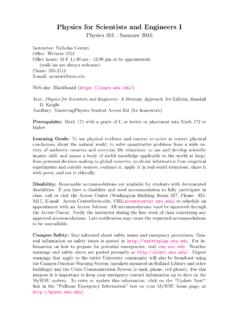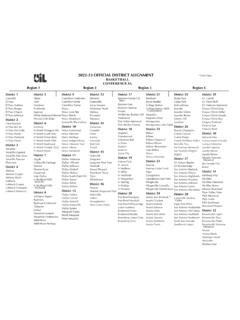Transcription of Bayesian Nash equilibrium - Washington State University
1 Bayesian Nash equilibriumFelix Munoz-GarciaStrategy and Game Theory - Washington State UniversitySo far we assumed that all players knew all the relevantdetails in a , we analyzed complete-information :Firms competing in a market observed each others productioncosts,A potential entrant knew the exact demand that it faces uponentry, , this assumption is not very sensible in several settings,where insteadplayers operate inincomplete information:Situations in which one of the players (or both) knows someprivate information that is not observable by the other :Private information about marginal costs in Cournotcompetition,Private information about market demand in Cournotcompetition,Private information of every bidder about his/her valuation ofthe object for sale in an auction,Incomplete information:We usually refer to this private information as privateinformation about playeri s type,qi2Qi While uninformed players do not observe playeri s type,qi,they know the probability ( , frequency) of each type in instance, ifQi=fH,Lg,uninformed players know thatp(qi=H)=pwhereasp(qi=L)=1$p,wherep2( 0,1).
2 Reading recommendations:Watson:Ch. 24, and Ch. 26 (this one is 4 1/2 pages long!).Harrington:Ch. 10 Let us rst:See some examples of how to represent these incompleteinformation games using game will then discuss how to solve them, , ndingequilibrium gameExample #1 Notation:GF:Player 1 makes a gift when being a "Friendly type";GE:Player 1 makes a gift when being a "Enemy type";NF:Player 1 does not make a gift when he is a "Friendly type";NE:Player 1 does not make a gift when he is a "Enemy type".Properties of payo s:1 Player 1 is happy if player 2 accepts the gift:1In the case of a Friendly type, he is just happy because the case of an Enemy type, he enjoys seeing how player 2unwraps a box with a frog inside!2 Both types of player 1 prefer not to make a gift (obtaining apayo of 0), rather than making a gift that is rejected (with apayo of -1).3 Player 2 prefers:1to accept a gift coming from a Friendly type (it is jewelry!!)2to reject a gift coming from an Enemy type (it is a frog!)
3 !)Another exampleExample #2 Player 1 observes whether players are interacting in the left orright matrix, which only di er in the payo he obtains inoutcome(A,C),either 12 or exampleOr more compactly..Player 2 is uninformed about the realization ofx. Dependingon whetherx=12 orx=0, player 1 will have incentives tochoose A or B, which is relevant for player example:Example #3 Cournot game in which the new comer ( rm 2) does not knowwhether demand is high or low, while the incumbent ( rm 1)observes market demand after years operating in the game with incomplete information:Example #4: Entry :E: enter,N: do not enter,P: low prices,P: with incomplete information (Example #5)Buyer has a high value from (10) or low valuation from (5) forthe object (privately observed), and the seller is uninformedabout such us turn to Harrington, Ch. 10 (Example #6)The "Munich agreement":Hitler has invaded Czechoslovakia, and UK s prime minister,Chamberain, must decide whether to concede on suchannexation to Germany or stand rm not allowing does not know Hitler s incentives as he cannotobserve Hitler s payo.
4 Let us turn to Harrington, Ch. 10 (Example #6)Well, Chamberlain knows that Hitler can either be belligerentor can we describe the above two possible gamesChamberlain could face by using a single tree?Simply introducing a previous move by nature whichdetermines the "type" of Hitler: graphically, connecting withan information set the two games we described ght in the wild west (Harrington, pp. 298-301)Example #7We cannot separately analyze best responses in each payo matrix since by doing that, we are implicitly assuming thatWyatt Earp knows the ability of the stranger (either agunslinger or cowpoke)beforechoosing to draw or Earp doesn t know that!How to describe wyatt Earp s lack of information aboutthe stranger s abilities?We can depict the game tree representation of this incompleteinformation game, by having nature determining the stranger sability at the beginning of the don t we describe the previous incomplete informationgame using the following gure?No! This gure indicates that the stranger acts rst, and Earpresponds to his action,the previous gure illustrated that, after nature determinesthe stranger s ability, the game he and Earp play issimultaneous; as opposed to sequential in this features in all of these games:One player observes some piece of informationThe other player s cannot observe such element , market demand, production costs, about his are now ready to describe how can we solve these , we want to apply the NE solution concept, into account that some players maximizeexpectedutility rather than simple utility, since they don t know whichtype they are facing ( , uncertainty).
5 Common features in all of these games:In addition, note that a strategysifor playerimust nowdescribe the actions that playeriselects given that hisprivately observed type ( , ability) , we will write strategysias the functionsi(qi).Similarly, the strategy of all other players,s$i, must be afunction of their types, ,s$i(q$i).Common features in all of these games:Importantly, note that every player conditions his strategy onhis own type, but not on his opponents types, since hecannot observe their s why we don t write strategysiassi(qi,q$i).If that was the case, then we would be in a completeinformation game, as those we analyzed during the rst half ofthe can now de ne what we mean by equilibrium strategypro les in games of incomplete Nash EquilibriumDe nition:A strategy pro le(s%1(q1),s%2(q2),..,s%n(qn))is aBayesian Nash equilibrium of a game of incompleteinformation ifEUi(s%i(qi),s%$i(q$i);qi,q$i)&EUi(si(q i),s%$i(q$i);qi,q$i)for everysi(qi)2Si, everyqi2Qi, and every words, the expected utility that playeriobtains fromselectings%i(qi)when his type isqiis larger than that ofdeviating to any other strategysi(qi).
6 This must be true forall possible types of playeri,qi2Qi,and for all playersi2 Nin the Nash EquilibriumNote an alternative way to write the previous expression,expanding the de nition of expected utility: q$i2Q$ip(q$ijqi)(ui(s%i(qi),s%$i(q$i);qi ,q$i)& q$i2Q$ip(q$ijqi)(ui(si(qi),s%$i(q$i);qi, q$i)for everysi(qi)2Si, everyqi2Qi, and every ,p(q$ijqi)represents the probability that playeriassigns, after observing that his type isqi,to his opponents types beingq$ Nash EquilibriumFor many of the examples we will explorep(q$ijqi)=p(q$i)( ,p(qi)=13), implying that the probability distribution ofmy type and my rivals types are is, observing my type doesn t provide me with any moreaccurate information about my rivals type than what I knowbefore observing my Nash EquilibriumLet s apply the de nition of BNE into some of the exampleswe described above about games of incomplete game (Watson Ch 24)Let s return to this game: Example #1 Notation:GF:Player 1 makes a gift when being a "Friendly type";GE:Player 1 makes a gift when being a "Enemy type";NF:Player 1 does not make a gift when he is a "Friendly type";NE:Player 1 does not make a gift when he is a "Enemy type".))
7 " Bayesian Normal Form" representationLet us now transform the previous extensive-form game intoits " Bayesian Normal Form" stepidentify strategy spaces:Player 2,S2=fA,RgPlayer 1,S1=nGFGE,GFNE,NFGE,NFNEo2nd step:Identify the expected payo s in each cell of #GFGE,A$,and its associated expected payo :Eu1=p)1+(1$p))1=1Eu2=p)1+(1$p))($1)=2p$ 1 Hence, the payo pair(1,2p$1)will go in the cell of thematrix corresponding to strategy pro le#GFGE,A$.2nd step:Identify the expected payo s in each cell of #GFGE,R$,and its associated expected payo :Eu1=p)($1)+(1$p))($1)=$1Eu2=p)0+(1$p))0 =0 Hence, the payo pair($1,0)will go in the cell of the matrixcorresponding to strategy pro le#GFGE,R$.Strategy#GFNE,R$,and its associated expected payo :Eu1=p)($1)+(1$p))0=$pEu2=p)0+(1$p))0=0 Hence, expected payo pair($p,0)a)#GFGE,A$!(1,2p$1):Eu1=p)1+(1 $p))1=1Eu2=p)1+(1$p))($1)=2p$1b)#GFGE,R$ !($1,0):Eu1=p)($1)+(1$p))($1)=$1Eu2=p)0+ (1$p))0=0c)#GFNE,A$!:Eu1=Eu2=d)#GFNE,R$! ($p,0):Eu1=p)($1)+(1$p))0=$pEu2=p)0+(1$p ))0=0 Practice:e)#NFGE,A$!
8 :Eu1=Eu2=f)#NFGE,R$!:Eu1=Eu2=g)#NFNE,A$! :Eu1=Eu2=h)#GFNE,R$!:Eu1=Eu2=Inserting the expected payo s in their corresponding cell, weobtain3rd step:Underline best response payo s in the matrix >12(2p$1>0))2 :#GFGE,A$and#NFNE,R$Ifp<12(2p$1<0))only one :#NFNE,R$If, for example,p=13#implying thatp<12$,the abovematrix becomes:Only one BNE:#NFNF,R$Practice:Can you nd two BNE forp=23?>12)2 plugp=23into the matrix 2 slides should nd 2 game with incomplete informationExample #2:Extensive form representation! gure in next that player 2 here:Does not observe player 1 s type nor his actions!longinformation RepresentationThe dashed line represents that player 2 doesn t observeplayer 1 s type nor his actions (long information set).Extensive-Form RepresentationWhat if player 2 observed player 1 s action but not his type:We denote:CandDafter observingA;C0D0after observingBExtensive-Form RepresentationWhat if player 2 could observed player 1 s type but not hisaction:We denote:CandDwhen player 2 deals with a player 1 withx=12C0andD0when player 2 deals with a player 1 withx= to construct the Bayesian normal form representation ofthe game in which player 2 cannot observe player 1 s type norhis actions depicted in the game tree two slides ago?
9 1st step:Identify each player s strategy ,DgS1=%A12A0,A12B0,B12A0,B12B0&where the superscript 12 meansx=12, 0 meansx= the Bayesian normal form is:Let s nd out the expected payo s we must insert in thecells..2nd step:Find the expected payo s arising in each strategypro le and locate them in the appropriate cell:a)#A12A0,C$Eu1=23)12+13)0=8Eu2=23)9 +13)9=9'!(8,9)b)#A12A0,D$Eu1=23)3+13)3=3 Eu2=23)6+13)6=6'!(3,6)c)#A12B0,C$Eu1=23) 12+13)6=10Eu2=23)9+13)0=6'!(10,6)Practic ed)#A12B0,D$Eu1=Eu2=e)#B12A0,C$Eu1=Eu2=f )#B12A0,D$Eu1=Eu2=Practiceg)#B12B0,C$Eu1 =Eu2=h)#B12B0,D$Eu1=Eu2=3rd step:Inserting the expected payo s in the cells of thematrix, we are ready to nd the of the game byunderlining best response payo s:Hence, the Unique is#B12B0,D$Two players in a disputeTwo people are in a dispute. P2 knows her own type, eitherStrong or Weak, but P1 does know P2 s , P1 is in good shape in (Fight, Fight) if P2 is weak,but in bad shape tree of this incomplete information game?!Extensive Form RepresentationS: strong; W: weak;Only di erence in payo s occurs if both players s next construct the Bayesian normal form representationof the game, in order to nd the BNEs of this Normal Form Representation1st step:Identify players strategy ,YgS2=%FSFW,FSYW,YSFW,YSYW&which entails the following Bayesian normal Normal Form Representation2nd step:Let s start nding the expected payo s to insert inthe cells.
10 1)#F,FSFW$Eu1=p)($1)+(1$p))1=1$2pEu2=p)1 +(1$p))($1)=2p$1'!(1$2p,2p$1)Finding expected payo s (Cont d)2)#F,FSYW$Eu1=p)($1)+(1$p))1=1$2pEu2=p )1+(1$p))0=p'!(1$2p,p)3)#F,YSFW$Eu1=p)1+ (1$p))1=1$2pEu2=p)1+(1$p))($1)=p$1'!(1$2 p,p$1)4)#F,YSYW$Eu1=p)1+(1$p))1=1Eu2=p)0 +(1$p))0=0'!(1,0)5)#Y,FSFW$Eu1=p)0+(1$p) )0=0Eu2=p)1+(1$p))1=1'!(0,1)Finding expected payo s (Cont d)6)#Y,FSYW$Eu1=p)0+(1$p))0=0Eu2=p)1+(1$ p))0=p'!(0,p)7)#Y,YSFW$Eu1=p)0+(1$p))0=0 Eu2=p)0+(1$p))1=1$p'!(0,1$p)8)#Y,YSYW$Eu 1=p)0+(1$p))0=0Eu2=p)0+(1$p))0=0'!(0,0)I nserting these 8 expected payo pairs in the matrix, weobtain:3rd step:Underline best response payo s for each for player 1 his payo 1$2pagainst 0, we ndthat 1$2p otherwise 1$2p< addition, for player 2 2p$1<psince2p$p<1,p<1,which holds by de nition, ,p2[0,1]andp>p$1 sincep2[0,1].We can hence divide our analysis into two cases: case 1,wherep>12;case 2, wherep-12!nextCase 1:p-121$2p&0 since in this casep-12.!that s why weunderlined 1$2p(and not 0) in the rst 3 , we found only one whenp-12:#F,FSYW$.














